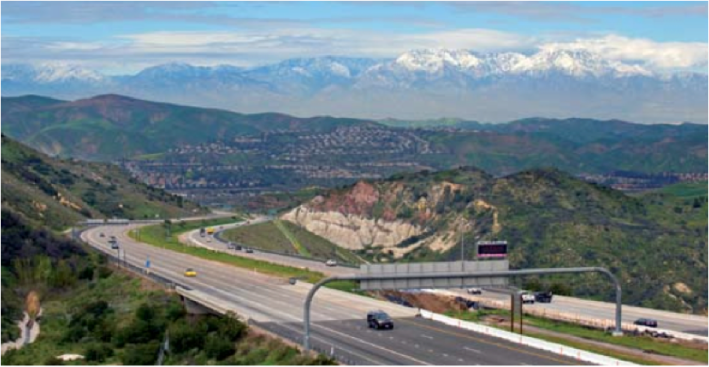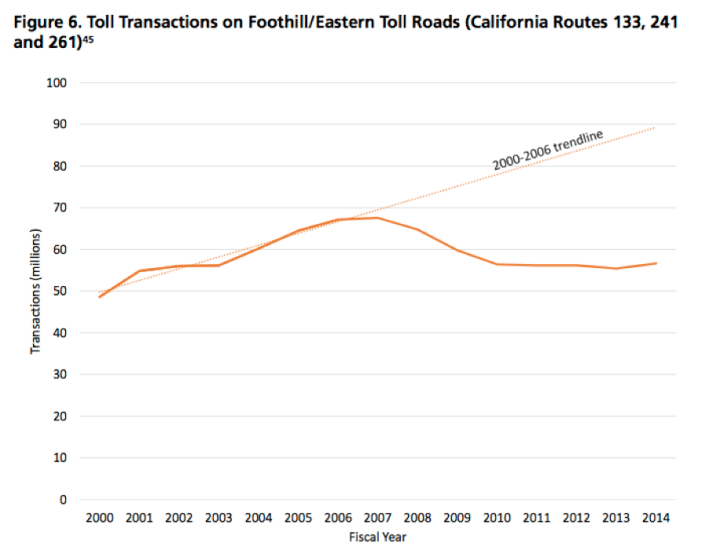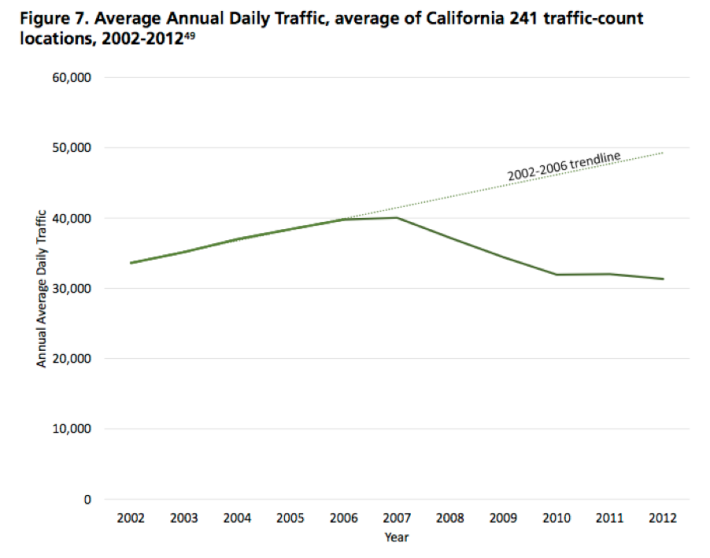
Today, U.S. PIRG and the Frontier Group released a new report, “Highway Boondoggles: Wasted Money and America’s Transportation Future.” In it, they examine 11 of the most wasteful, least justifiable road projects underway in America right now.
This week we've previewed the report with posts about the proposed Effingham Parkway in Savannah, Georgia and the harebrained scheme to widen I-240 through Asheville, North Carolina. Here we continue with an egregious example from the Golden State.
Southern California’s toll road agency has proposed extending an existing toll highway that might eventually span inland Orange County and connect to Interstate 5. The number of cars on previous sections of the highway, however, have failed to meet projections. Also, the agency is already struggling to avoid default on its debts.
California 241 is one of several toll roads in Orange County built and operated by the legislature-created Transportation Corridor Agencies (TCA). California officials enabled the creation of toll roads in the area in the late 1980s amid both a shortage of state transportation funding and the perception of insatiable demand for more highways.
Traffic on California 241, however, hasn’t met official projections for a decade. In recent years -- and especially since the collapse of the housing bubble in 2007 -- driving on existing sections of California 241 has declined.
The TCA measures road use by counting the number of transactions conducted by toll payers on the combined Foothill/Eastern Toll Roads, which include not only Route 241 but also Routes 133 and 261. The TCA’s count shows fewer transactions in fiscal year 2014 than in fiscal 2004. As indicated by the dotted trend line below, there were about 32 million fewer transactions in fiscal year 2014 than would have been expected if the trend from 2000 to 2006 had continued.

TCA data do not allow measurement of traffic on Route 241 alone, but California Department of Transportation data do and show a similar trend: Traffic peaked in 2007 and has not shown a return to that level. By 2012, the most recent year for which data are available, traffic on Route 241 was lower than it was in 2002. (See Figure 7, below.) Traffic is 36 percent lower than it would have been if pre-2006 trends had continued. As a result, toll revenue has not met projections since 2007. The toll roads’ system-wide revenue has been so low that the TCA was recently at risk of defaulting on $2.4 billion in bonds.
Despite the trend of declining road use, the TCA has proposed a $200 million “Tesoro Extension” project to extend the road 5.5 miles, in what the agency intends to be the first stage of a 16-mile extension of Route 241. The project would add to the financial liabilities of an agency that is already in trouble.
The TCA’s financial woes come despite several attempts by the state of California to help the agency. The agreement between the Transportation Corridor Agencies and the state’s transportation agency, Caltrans, lets the TCA borrow money to build roads, and then collect tolls until its roads’ construction and operations debts are repaid, after which point the highways would become free to all drivers.
While the bonds are not backed by the state of California, Caltrans, which maintains the TCA’s roads, must approve any refinancing that would extend the TCA’s debt repayment schedule. In 1997, the TCA got permission to extend tolling on California 241 and two nearby toll roads (Routes 133 and 261) from 2033 to 2036, to get more time to pay off the roads’ construction costs. In 2011, the TCA was allowed to extend that time further, to 2040. In 2013 it asked for and received approval to extend tolling even longer, to 2053. As a result of stagnant driving and the TCA’s financial woes, drivers in Orange County will be paying tolls on these roads for decades longer than originally anticipated.
The TCA has also raised toll rates, which, Businessweek reported, “helped the agency’s revenue reach a record $111.8 million... even as the number of vehicles using the roads fell to a 12-year low.” The TCA’s finances show no sign of improvement -- income has been “about 75 percent of projections,” according to Businessweek.
These facts have led critics to assail the financial case for the extension plan. An analysis by the free-market-supporting Pacific Research Institute found “there is scant evidence that the viability of the 241, which is currently questionable, is improved with the extension.” Concluding that drivers are not willing “to pay a toll that is high enough to cover all maintenance, operational, and capital investments necessary to support the road,” the Pacific Research Institute declared, “spending money on plans to extend the 241... is not justifiable and should cease immediately.”
Phineas Baxandall, senior policy analyst at U.S. PIRG, and Jeff Inglis, policy analyst at the Frontier Group, are co-authors of the report, “Highway Boondoggles: Wasted Money and America’s Transportation Future.”






